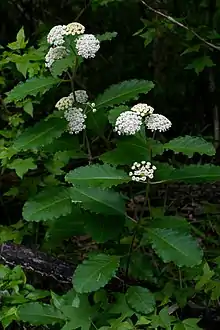| Asclepias variegata | |
|---|---|
 | |
| Scientific classification | |
| Kingdom: | Plantae |
| Clade: | Tracheophytes |
| Clade: | Angiosperms |
| Clade: | Eudicots |
| Clade: | Asterids |
| Order: | Gentianales |
| Family: | Apocynaceae |
| Genus: | Asclepias |
| Species: | A. variegata |
| Binomial name | |
| Asclepias variegata | |
| Synonyms | |
|
Biventraria variegata (L.) Small | |
Asclepias variegata, commonly called the redring milkweed[1] or white milkweed,[2] is a plant in the family Apocynaceae. It is native to eastern North America, where it is found in Canada and the United States.[3] It is most common in the Southeastern United States, and becomes rare in the northern edge of its range.
Its natural habitat is forest openings and savannas, often in sandy soils.[4]
It produces small white flowers with purplish centers that area crowded into round, terminal clusters.[5] It flowers in early summer.[2]
Conservation status in the United States
It is endangered in the states of New York, and Pennsylvania.[6] It is listed as a special concern species and believed extirpated in Connecticut.[7]
References
Wikimedia Commons has media related to Asclepias variegata.
- ↑ USDA, NRCS (n.d.). "Asclepias variegata". The PLANTS Database (plants.usda.gov). Greensboro, North Carolina: National Plant Data Team. Retrieved 26 August 2017.
- 1 2 Alan Weakley. "Flora of the Southern and Mid-Atlantic States".
- ↑ "Asclepias variegata". County-level distribution map from the North American Plant Atlas (NAPA). Biota of North America Program (BONAP). 2014. Retrieved 14 October 2017.
- ↑ Yatskievych, George (2006). Flora of Missouri, Volume 2. Missouri Botanical Garden Press. pp. 156–157.
- ↑ "Lady Bird Johnson Wildflower Center - The University of Texas at Austin". wildflower.org. Retrieved 27 August 2017.
- ↑ "Plants Profile for Asclepias variegata (Redring milkweed)". plants.usda.gov. Retrieved 30 December 2017.
- ↑ "Connecticut's Endangered, Threatened and Special Concern Species 2015". State of Connecticut Department of Energy and Environmental Protection Bureau of Natural Resources. Retrieved 31 December 2017.(Note: This list is newer than the one used by plants.usda.gov and is more up-to-date.)
This article is issued from Wikipedia. The text is licensed under Creative Commons - Attribution - Sharealike. Additional terms may apply for the media files.